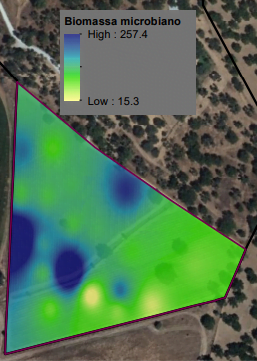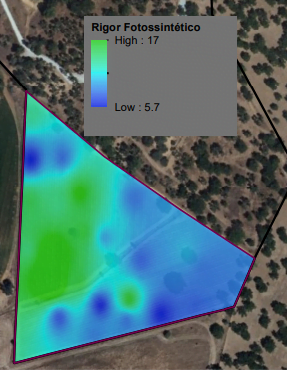AgrosustentáveL – Pest and disease control by nutrition… A possibility or a utopia?
ABSTRACT
We all know that climate change can affect production and each one of us should play an important role to reduce that impact. Therefore, we decided to decrease the use of pesticides, betting on nutrition to strengthen the resistance to pests and diseases and we are also less dependent on fossil fuels (reducing the number of hours of tractor work, for example) once more carbon can be sequestered with the introduction of regenerative practices.
Our case study was applied on 4 hectares which are part of 27 ha of Montado de Sobro area of coverage. The whole property is certified in Organic Agriculture and it has also 50 sheep. This regenerative project started a year ago taking advantage of the existing ecological infrastructures (vegetal cover), a tractor, a sprayer and a shredder.
Before starting the regeneration project and in order to increase control and management efficiency, we raised our “zero” point in several soil indicators among which we highlight microbial carbon, microbial biomass, the quantity of enzymes (dehydrogenase, urease, phosphatase) and soil infiltration.
In order to nourish the vegetation cover and create biomass in between the land lines, we have built a soil microbiology multiplier and acquired equipment to measure the ratio of fungi: compost bacteria, thus checking the quality of organic fertilizers.
To control plant health, we are evaluating physiological parameters such as chlorophyll levels in the plant and monitoring the dynamics of minerals as well as the brix in the plant’s sap.
STARTING DATE: 2020 ENDING DATE: on going
SUSTAINABLE TARGET:
- Increase carbon sequestration to rise the resilience of the vineyard ecosystem
- Reduce our dependence on fossil fuels
- Reduce our dependence on the application of pesticides (copper and sulphur)
PARTNERS
Herdade da Amoreira de Cima
University of Évora
COMPANY SUMMARY:
We are a consulting company with over 30 years of field experience in the area of sustainability and we encourage producers to produce without pesticides by promoting the health of not only the soil but also the plant.
We are based in a hot and dry region, with frequent heat waves and little annual precipitation, usually concentrated during the cooler months. In monitoring some vine performance indicators, we realized that the resilience of plants to extreme climatic phenomena is closely related to the quality and nutritional balance of the crop and to the health of the soil.
Since then, we have been taking a more holistic approach by focusing our process on the soil quality. This led us to the following question – “If in 1 acre we only use 1/3 of the cash crop area, how will we take advantage of the other 2/3 of the area in order to improve soil health and mitigate the effect of climate change on our vineyard?”
What we come to propose is, therefore, the eco-intensification of the entire ecosystem, from covercrop to cashcrop and the whole environment around, making use of precision viticulture tools to improve our management efficiency.
REASON WHY/ MOTIVATION
If we are increasingly dependent on extreme phenomena then we think we should have our soil / crop prepared for those critical moments and that means we will have to be able to deal with temperature, precipitation or wind. So, we must put the ecosystem to work so we may increase the resilience of plants to biotic and abiotic factors.
We believe that nutrition can control these factors. As with humans, a balanced diet and exercise are synonymous of high physical and health indices.
We want to replace the use of pesticides (copper and sulphur) with nutrients and of fossil fuels by reducing the number of hours our tractor works.
DESCRIPTION and STRATEGIES
When we started our vine management work at Herdade da Amoreira de Cima, the covercrop was already sown with legumes (red clover, white clover, sawdust) and grass (festuca, oats) and others such as Sula. During 2019, we nourished the covercrop and delayed mowing to increase biomass production, thus achieving a high rate of soil cover.
The creation of biomass between rows of the vine involves the tasks of inoculating and nourishing the soil with compost tea which will join the compost we intend to apply; then we evaluate the quality of the soil by measuring the microbial load and the fungus in order to find quality bacteria.
In the vineyard row, the biomass is controlled by a cutting implement, without any soil disturbance.
In 2020, to increase our management efficiency and strategy alignment, we decided to raise our “zero” in several parameters, such as:
- Soil microbiology indicators
- Plant physiological indicators
- Soil infiltration
- Soil compaction
In this first survey, we chose 24 georeferenced points in the vineyard and each point has an area of influence of 0.15 acres (1500 square metres).
The georeferencing of the points allowed to create maps in a GIS environment to assess the spatial variability of the different indicators.


In order to control the health of the plant, in 2020 we began to carefully monitoring not only the nutritional balance of minerals, by analysing sap, but also the brix of the plant.
The farm also has 50 sheep that are taken to the vineyard only during the winter, until the budbreak. In addition to the initial control of biomass between the land lines, they also contribute to the fertilization of the vine.
The strategy is to improve the synergism between plant and soil microbiology. Thus, we intend to enhance the soil microbiological activity using practices that benefit carbon sequestration (the energy for microbes) and increase the efficiency of the plant in the production of photoassimilates with constant control of the balance between cations, anions and micronutrients which circulate in the plant.
ACHIEVEMENTS SO FAR
We are starting the journey, however, the fact that we have measured several indicators allowed us to adjust and increase the efficiency of the temporal and spatial management of the plots.
The control of nutrition in “real time” allowed us to verify the dynamics of ions circulating within the plant. We highlighted nutrition in microelements and nitrogen management and its protein synthesis. These elements are important in increasing the plant’s resistance to pests, diseases and other abiotic factors.
During the 2020 campaign, which was very demanding in controlling Leafhopper (Empoasca vitis); many producers performed more than 3 treatment, we did none.
The monitoring of the brix led us to exceed 12 of Brix and we were very close to 15.
The measurements of soil infiltration allowed us to find that the dominant plant species in the vegetation cover have a strong impact on the water absorption speed. During the autumn of 2020, more than 250mm rained, 115mm in a single day. After this period of heavy rain, we did not see any visible runoff or loss by erosion, a sign that we have improved the infiltration of our soil.
So, by doing an analysis of the indicators we have, we may conclude there is a relationship between microbial biomass and chlorophyll content.
LESSONS LEARNED
Measure, measure and measure a lot
Whatever is the indicator to be used, we must abandon the casual so that we can increase the efficiency of our management and balance what we ourselves often unbalance.
If we compare the pressure of the Leafhopper pest between neighbouring vineyards and the Amoreira de Cima vineyard, it will lead us to believe that a correct management of the nutritional balance is essential to help in controlling the pest and other biotic and abiotic problems.
The composition of the covercrop is important for the performance of the soil in its capacity to absorb rainwater.
NEXT STEPS
Continue to measure the several indicators. we have to verify the performance of the soil and the plant
Identify and monitor functional biodiversity in order to do the selection and installation of ecological infrastructure.
POTENTIAL FOR REPLICATION
Total

